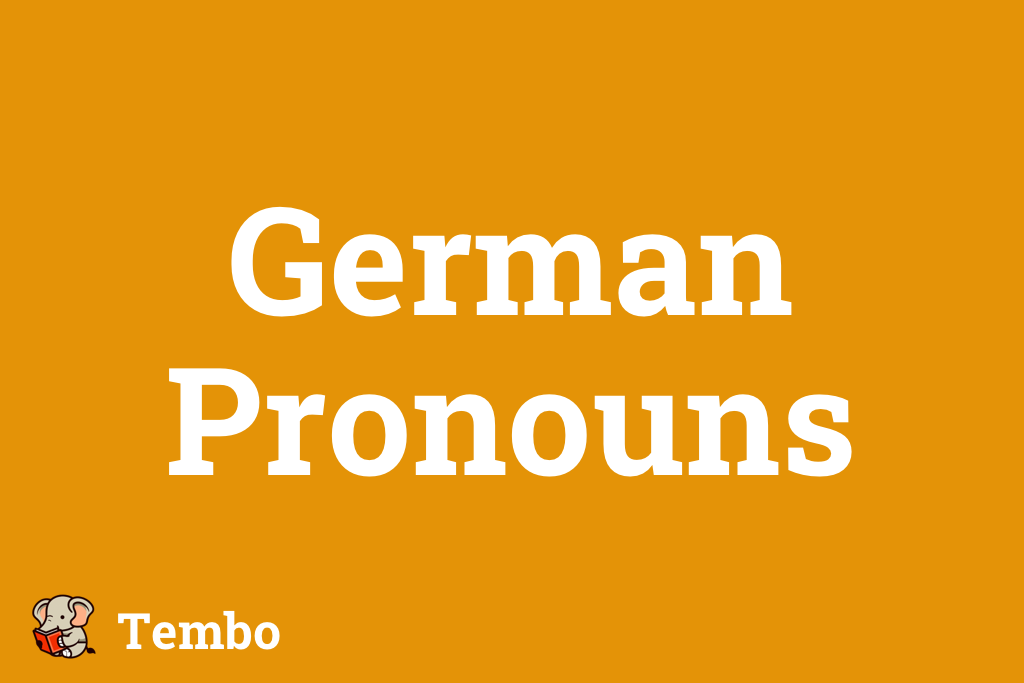The Basics of German Pronouns
Pronouns - those small, yet potent words in a language that can often seem perplexing, especially in German. They are more than just placeholders or shortcuts in a sentence. They give our sentences variety and make our language vibrant and less repetitive. For English speakers, German pronouns might appear daunting at first glance due to their varied forms based on gender, case, and number. However, the mystery begins to unravel as you step into the world of German pronouns, revealing logical patterns and making the language considerably more accessible.

What are Pronouns?
Pronouns are words used in place of a noun. They are the shortcut we use when we don't want to repeat the name of the person, animal or thing we're talking about. Pronouns are vital for constructing sentences and expressing ideas clearly. In German, there are several types of pronouns: personal, possessive, demonstrative, relative, reflexive, and indefinite.
Personal Pronouns
In English, personal pronouns are quite straightforward - I, you, he, she, it, we, you, they. But in German, each personal pronoun has a nominative, accusative, dative, and genitive form. Let's look at the table below for a clearer picture:
| Nominative | Accusative | Dative | Genitive | |
|---|---|---|---|---|
| I | ich | mich | mir | mein |
| You | du | dich | dir | dein |
| He | er | ihn | ihm | sein |
| She | sie | sie | ihr | ihr |
| It | es | es | ihm | sein |
| We | wir | uns | uns | unser |
| You | ihr | euch | euch | euer |
| They | sie | sie | ihnen | ihr |
| You (formal) | Sie | Sie | Ihnen | Ihr |
Here's an example sentence:
"Ich sehe den Hund." (I see the dog.) "Er sieht mich." (He sees me.)
Notice the change from "Ich" to "mich" when "I" becomes the object of the sentence.
Possessive Pronouns
In English, we use my, your, his, her, its, our, their to show ownership. In German, possessive pronouns change according to the gender (masculine, feminine, neuter) and case (nominative, accusative, dative, genitive) of the noun they modify. Here are the nominative forms:
| Masculine | Feminine | Neuter | Plural | |
|---|---|---|---|---|
| My | mein | meine | mein | meine |
| Your | dein | deine | dein | deine |
| His | sein | seine | sein | seine |
| Her | ihr | ihre | ihr | ihre |
| Its | sein | seine | sein | seine |
| Our | unser | unsere | unser | unsere |
| Your | euer | eure | euer | eure |
| Their | ihr | ihre | ihr | ihre |
For example:
"Das ist mein Buch." (That is my book.) "Das ist ihre Katze." (That is her cat.)
Remember, these possessive pronouns change according to the gender and case of the noun they are referring to!
Demonstrative Pronouns
Demonstrative pronouns in German, 'dieser' (this) and 'jener' (that), help specify or point out the person or object we're referring to. Just like possessive pronouns, they change according to the gender, number, and case of the noun they are replacing or referring to. For instance, "Dieser Hund ist groß" (This dog is big) or "Jene Frau ist nett" (That woman is nice). Notice how 'dieser' and 'jener' change according to the gender of the noun.
Reflexive Pronouns
Reflexive pronouns are used when the subject and the object of a sentence are the same, like in the sentence "I see myself". In German, reflexive verbs often require the use of reflexive pronouns. For example, "Ich sehe mich" (I see myself). They change according to the case (accusative or dative) required by the reflexive verb in the sentence. For instance, "Ich putze mir die Zähne" (I brush my teeth) or "Er hat sich das Bein gebrochen" (He has broken his leg). In these examples, 'mir' and 'sich' are reflexive pronouns, reflecting the action back onto the subject.
Relative Pronouns
Relative pronouns in German connect clauses in a sentence and relate back to a noun or pronoun previously mentioned. They change according to the gender, number, and case of the noun they refer to. For example, "Das ist der Mann, den ich gestern getroffen habe" (That is the man whom I met yesterday) or "Die Frau, deren Buch ich lese, ist berühmt" (The woman, whose book I'm reading, is famous). In these sentences, 'den' and 'deren' are relative pronouns referring back to 'der Mann' and 'die Frau', respectively.
Indefinite Pronouns
Indefinite pronouns are used when you want to refer to an unspecified person or thing. In German, common indefinite pronouns include 'jemand' (someone), 'etwas' (something), 'alle' (everyone), 'nichts' (nothing), 'niemand' (no one), and many others. For instance, "Hat jemand meinen Schlüssel gesehen?" (Has someone seen my key?) or "Ich habe nichts gemacht" (I did nothing). In these examples, 'jemand' and 'nichts' are indefinite pronouns referring to an unspecified person and thing, respectively.
Leave a Reply